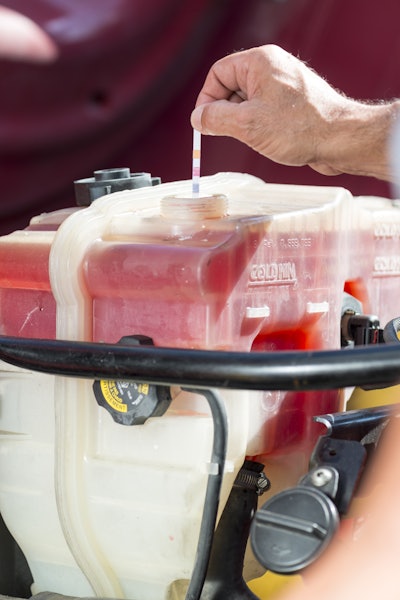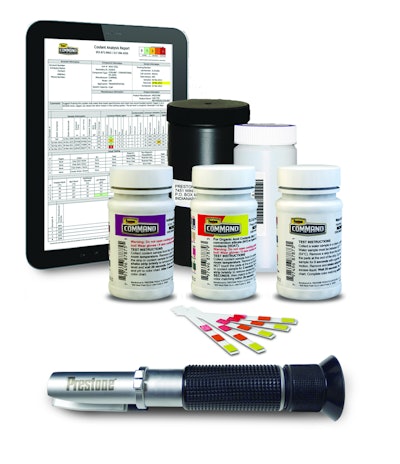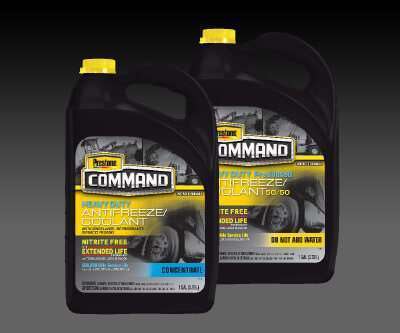
So the best way to beat the heat is to maintain the best-running coolant system possible in your heavy-duty truck or van.
To that end, Hard Working Trucks turned to the antifreeze/coolant (AF/C) experts at Prestone. They went above and beyond answering our questions and provided valuable insight and advice on AF/C best practices.
How often does Prestone recommend testing coolant in HD applications?
For testing, we have to take into consideration what is happening when the vehicle is on the road. Fleets should test the coolant at every oil change. It does not matter which coolant the fleet uses in the vehicle, Supplemental Coolant Additive (SCA)-Precharge or a type of Extended Life Coolant (ELC). The concern is when the vehicle is on the road, what coolant is used for top-off. This is where different coolant technologies are mixed, and if not caught in time, can be an expensive repair later down the road.
Here is a good example of a testing practice to follow, an SCA-Pre-Charge coolant should be tested every 25,000 miles and an ELC at every PM oil change. Cooling system maintenance practices are also listed under TMC and OEM guidelines.
What are some of the challenges faced in an HD cooling system?
Coolant type: The most immediate concern for heavy duty operators has to be maintaining their heavy duty fleet’s cooling system levels with the appropriate type of antifreeze/coolant (AF/C). Potential problems that can occur when using the wrong type of coolant range from oil degradation, boilover or freezing to cavitation pitting, rust/corrosion buildup or water-pump failure. Utilizing the wrong type of coolant can also initiate hose leaks, with subsequent high-volume coolant loss, reduced driving comfort and potential engine breakdown. That’s why it is important to determine the effect a coolant will have on the cooling system/engine parts and materials. When choosing the appropriate type of coolant, it is important to understand that you should not assume colors on the packaging are the color of the contents in the bottle. It is not uncommon to find red or purple labeling, or colored caps, on products that might not correlate to the content’s color or formulation. Always read the label to be sure you are buying the appropriate coolant for your system.

Corrosion: Rust and corrosion can ruin the efficiency of a cooling system. Cooling-system problems can result from the deterioration of any material within the engine, or supporting systems. OEMs provide guidelines for coolants in their engines, but no engine can operate efficiently with deposits on metal surfaces, which will slowly impair an engine’s performance as coolant flow can become restricted, which inhibits the system’s ability to adequately cool or transfer heat from the key components. As the operation of the engine consumes corrosion-fighting additives, Supplemental Coolant Additives (SCA) must be periodically added to systems with conventional IAC and Hybrid Organic Acid Technology (HOAT) coolants to maintain effective corrosion protection. Organic Acid Technology (OAT) and Nitrited Organic Acid Technology (NOAT) coolants do not require SCAs.
Please briefly describe the Prestone Command test kits, test strips and refractometer.

By providing an easy way to test an engine cooling system, essential preventative maintenance can be convenient and highly accurate.
There are a number of ways to test your AF/C to ensure you are ready for any situation or condition. Prestone Command offers a full line of AF/C testing methods. These testing options vary in complexity and scope, offering the ability to test a wide range of important variables from basic glycol concentration to far more complete methods that measure condition of the fluid and the ability of the AF/C to protect the engine from corrosion by measuring the level of inhibitors.
Prestone Command Test Kits: Prestone Command offers three different test kits to meet the various challenges heavy duty engine AF/C may encounter. The detailed analysis provides a snapshot of what is happening with AF/C inside your equipment. It tells you the condition of the fluid and identifies component wear and contamination in engines so that you can: safely extend drain intervals and equipment life; maximize asset reliability; minimize downtime.
Prestone Command Test Strips: Three specifically-designed Test Strips to assist in determining:
- AFC210 – Water Quality Test Strips: Hardness/pH/Chloride
- AFC220 – IAT (SCA-Charged) Antifreeze/Coolant Test Strips: Nitrite/Freeze Point/pH
- AFC240 – ELC (NOAT, OAT) Antifreeze/Coolant Test Strips: Freeze Point/Inhibitors/Nitrite/pH
Prestone Command Hand-Held Refractometer:
- Measures concentration and freezing temperature of ethylene and propylene glycol-based AF/C
- Easy-to-use, customer-friendly portability, providing a wide range measurement
- Provides a dual-scale and temperature compensation
What’s the typical lifespan of Prestone Command coolant? What makes it different from other coolants?

- Prestone Command Heavy Duty Nitrite Free Extended Life Antifreeze/ Coolant (ELC) is an Organic Acid Technology (OAT). Its patented, technologically advanced formulation is based upon a concentrated blend of premium long-lasting inhibitors designed to provide up to 600,000 miles/12,000 hours of protection against temperature extremes, rust, corrosion, scale, and premature water pump failure.
- Prestone Command Heavy Duty Extended Life Antifreeze/Coolant (ELC) is a Nitrited Organic Acid Technology (NOAT). Its patented technologically advanced formulation is based upon a concentrated blend of premium long-lasting inhibitors designed to provide up to 600,000 miles / 12,000 hours of protection against temperature extremes, rust, corrosion, scale and premature water pump failure.
- Prestone Command Heavy Duty Extended Service Interval Antifreeze/Coolant is formulated with advanced corrosion protection technology. This provides an exceptional SCA pre-charged Extended Service Interval (ESI) Technology product, which is compatible with any conventional HD coolants, and ALL filter technologies. When Extended Service Interval coolant is properly maintained the service life can be up to 300,000 miles. The fleet can actually take it 600,000 miles as long as it passes testing and is properly maintained. Testing would include strip testing every 25,000 miles and completing a lab analysis once every year to take it beyond the 1-year or 150,000 miles (follows both TMC and OEM recommended practices).
- See PrestoneCommand.com for additional product detail and specifications.
How often does Prestone recommend flushing an HD coolant system?

- First, flush per the vehicle and/or engine manufacturer’s recommendations (coolant change interval).
- Any time you are doing major engine re-hauling or changing a cooling system component that has failed (if the part has failed. i.e. water pump, etc.). You don’t want the same coolant left in the vehicle with the new parts
- Any time the coolant becomes contaminated (with a different functional fluid. i.e. oil, DEF, washer fluids, etc.)
- If you have combined different coolant technologies and the concentration of that mix exceeds the vehicle or engine manufacturers recommendations.
What are the benefits of flushing an HD coolant system and replacing the coolant?
If contamination is suspected or detected, the only way to truly rid the system of all contaminants is to completely flush the system. A good rule of thumb is, “when it doubt, flush it out!”
Oxalic acid used to be the chemical of choice in coolant flushes. What’s the primary cleaning agent in Prestone Command’s new 2-in-1 flush/degreaser that gets the job done?
While it’s true that in years past oxalic acid was the primary acid used in flush products, changes in technology have necessitated a change in formulation. Oxalic acid is very aggressive and eats away at aluminum components much too quickly to be safe.
Prestone developed the Command 2 in 1 Flush and Degreaser to be safe for all cooling system components, which means we shifted to a less corrosive but no less effective acid formulation. We have combined the acid treatment with a patent pending oil removal system that can strip oil and grease from metal surfaces, encapsulate them, and flush them out of the system.
What really differentiates this product from all other products on the market, is with Command 2 in 1 Flush and Degreaser you can now remove both corrosion products including rust and aluminum oxide, silicates, and oil in a single step. Other products require 2 products and 2 separate flushes, increasing down-time, cost, and SKUs in inventory.









